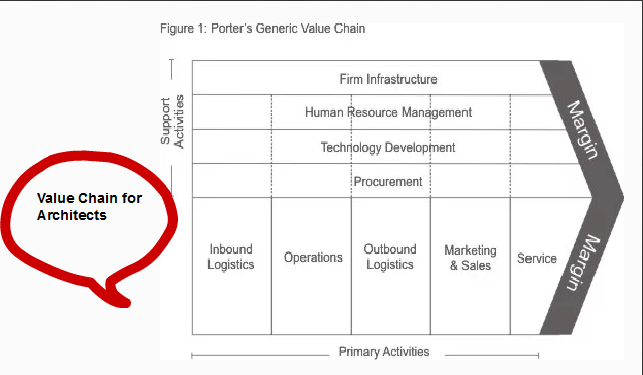
This topic came to my mind while I was chatting with my cousin over the weekend who was presenting on this topic as a part of the CII ( Confederation of India Industry ) conference. He works for a mechanical company and was to present the business benefits in his company. They had optimized their existing set of process to reduce the cycle time of churning new products. They had mapped their existing process structure from the point where the raw materials are procured to the place where they undergo various levels of transformation / integration to finally give that polished output. This happens as a part of various business process work flows. He had his presentation ready and was to explain how useful this technique is for extracting maximum enterprise value in an organization.
What does Value Stream mean to an architect ?
A value chain diagram provides a high-level orientation view of an enterprise and how it interacts with the outside world. The purpose of this diagram is to quickly on-board and align stakeholders for a particular change initiative, so that all participants understand the high-level functional and organizational context of the architecture engagement.
Porter’s Value Chain analysis is used to develop a focus on those activities within your Company that significantly add value and thus give you a competitive edge. For instance, if your team is very good at analysis and design such that you can define and bound a problem better than anyone else in the world, you could put in a process to continually implement new design and analysis methods and disseminate that throughout the organization so that you are always the best. And you can lead with that in your marketing efforts by calling that out as a “feature” and highlighting the benefits to the customer of lower development cost, more robust solutions, etc. Value Chain Analysis is a way to get at your key competencies which create differentiated products and services.
Although the above diagram can look like more of an MBA kind of material trying to unify the business problem and the IT solutions to plug the same. As you progress in your careers you are expected to understand both the business and the IT sides of the equation well and this is a useful tool to help one with the mental model for the same. This is very useful in getting discussions started with the customer and quite handy during consulting and internal process revamp exercises.
As far as architects are concerned their efforts should be focused on activities that bring the highest business value to the organization and the customer. This needs them to understand in the sense of what constitutes primary and secondary activities that bring value to the end customer. Once this is understood the organization can pull the strings in the right direction and focus its efforts in the right direction. Here is leaving you with a brief intro video on what is value chain https://www.youtube.com/watch?v=g8p2H7EvoGM.





